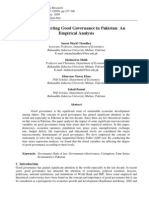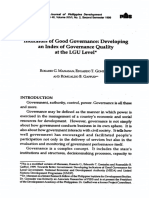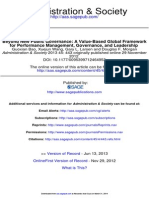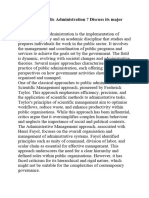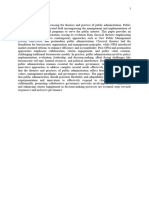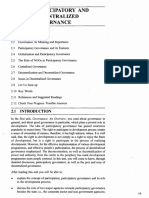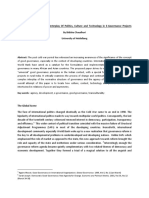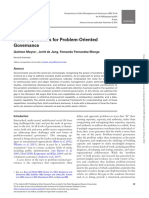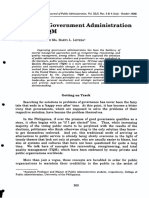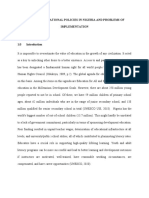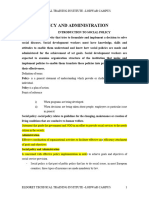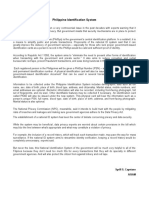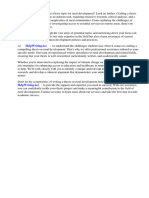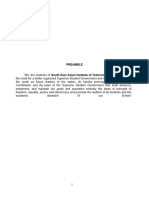Administrative Reform in Jordan
Administrative Reform in Jordan
Uploaded by
Sanjoyo Setwo PrabowoCopyright:
Available Formats
Administrative Reform in Jordan
Administrative Reform in Jordan
Uploaded by
Sanjoyo Setwo PrabowoOriginal Title
Copyright
Available Formats
Share this document
Did you find this document useful?
Is this content inappropriate?
Copyright:
Available Formats
Administrative Reform in Jordan
Administrative Reform in Jordan
Uploaded by
Sanjoyo Setwo PrabowoCopyright:
Available Formats
International Review of Management and
Marketing
ISSN: 2146-4405
available at http: www.econjournals.com
International Review of Management and Marketing, 2015, 5(2), 45-51.
Administrative Reform in Jordan: Urgency for Reforming the
Bureaucracy Structure
Rami Mohd Tbaishat*
Department of Public Administration, Yarmouk University, Irbid, Jordan.*Email: rururami@hotmail.com
ABSTRACT
This study aimed to provide a diagnostic-analytic study of the characteristics of administrative reform experience in Jordan with a view to identify the
pitfalls and shortcomings that accompanied it, based on assumptions in conducting reform. During the last 20 years, Jordan has witnessed a considerable
effort in administrative reform. The result of such reform programs have fallen short of expectations and were rather limited in impact. Therefore,
the analysis focused on the conditioned, under which the governing structure works efficiently, and how Jordan can direct its resources toward the
achievement of efficiency in the public service with special emphasis on the bureaucracy structure. The study revealed that the private sector itself
is unable to participate significantly in absorbing the labor force into the economy as a result of the monopoly problems existing in the public sector.
Moreover, the lower share of spending on the capital category is vital in classifying the merits of government economic policies. Therefore adaptability
is key to any reform and reorganization plan in which contingencies must be embedded in the process of organizational change and administrative action.
Keywords: Jordanian Bureaucracy, Good Governance, Administrative Reform, State
JEL Classifications: D71, D73, D78, H11
1. INTRODUCTION “shift from government to governance” (Aron, 2014). This shift
involves the focus of administrative practice moving outside the
Public administration in Jordan faces immense challenges. These walls of government-away from the bureaucratic state and direct
include the need to maintain peace and harmony, to alleviate deep government provision of services and toward what has been
poverty, to sustain a healthy and inclusive economic growth, to called third party government (Wachhaus, 2010). In other words,
ensure social justice and to achieve ethical, efficient, transparent the ways in which we govern are moving beyond governmental
and participative governance (UN Human development boundaries - The traditional mechanisms and institutions of
Report, 2008). The sort of public administration needed to escalate government are becoming less involved with, and less central to,
the growth rate may not necessarily be the one that tackles poverty
the ways that we govern ourselves (Noveck, 2009).
problems, seeks to remove inequality, tackles corruption to ensure
speedy justice.
The overwhelming challenge of the changing times, however,
has recently given birth to soul-searching among scholars and
According to Amster (2012, p. 33), the New Public
practitioners in this field. This rethinking ran along the following
Management - has been called market based public administration
sought to bring management professionalism to the public sector lines: is the traditional bureaucracy adequate to cope with
without necessarily discarding the active role and welfare goals social, economic, and political changes? Is it geared to national
of the state, and offered the possibility of a more cost-effective development, which is the expressed goal of practically all
and citizen-friendly state, and the possibility of substantially governments? Should not the focus be turned from mere system
enhancing the governance capacity of the State for tackling the maintenance to active pursuit of development? Should not
highly complex challenges of our time. The patterns of governing more attention be paid to the innovative aspect of government
structure are changing in ways that have been captured as the administration?
International Review of Management and Marketing | Vol 5 • Issue 2 • 2015 45
Tbaishat: Administrative Reform in Jordan: Urgency for Reforming the Bureaucracy Structure
Scholars in public administration, political science, economics, broad participation in public policy-making processes and equity in
and other related disciplines are not lacking in ideas for bridging the distribution of and access to public services (Leftwich, 1994).
transitional stages from a state of scarcity to one of abundance.
The obvious question, which arises, however, is in what way The challenge is how to reach a balance between the demands
would one type of administrative reform directly result in national for improving the operations of a free market in the neoliberal
development? Had there been satisfactory analysis to this question, tradition of capitalism and the need to reinstate and improve some
there would be no problems in achieving the required growth that of the traditional institutions and processes associated with the
was expected in the last decade. workings of a democratic welfare state (World Bank Ministerial
Seminar, 1996).
2. RESEARCH METHODOLOGY
According to Abu Shair (1997, p. 129), the analysis of the
transitional experience suggest that the role played by the public
The study focused on providing a diagnostic-analytic study of the
bureaucracy in the process of societal change needs to be closely
Jordanian public administration in order to identify the pitfalls and
examined whether one is interested in emphasizing the key
shortcomings that accompanied them. In this analytical process
values and practices associated with neoliberalism-free market,
the study examined and presented the important characteristics
deregulation, privatization, and so on. Or whether one is interested
of rival explanations in administrative reform. Pattern-matching
in developing an administrative state that plays a key role as
is a well-known mechanism in this kind of studies, where several
regulator and promoter of an equitable pattern of socioeconomic
cases may be known to have a certain type of outcome, and the
development. Clearly public bureaucracy plays a central role as
investigation focused on how and why this outcome occurred
influential political actor in each and all phases of policy-making
in each case. A common policy problem is to understand the
processes-formation, implementation, and evaluation.
conditions under which research and development can be made
useful to society.
In its attempts to respond to the urbanization issues through
national economic policies, the state became the instrument
This model is useful in explaining and understanding the
for achieving a wide variety of new conflicting goals ranging
approaches and motives of reforms and reorganizations
from regulating and promoting economic and social activities to
undertaken by modern governments. They also provide conceptual
ensuring social integration and equality.
frameworks for analysis of organization and reorganization of
modern governance and public administration.
The state is characterized by institutional development with
long-lasting consequences for the public administration. First,
In doing so, the analysis and explanation focused on the conditions
organizationally, the state expands the scope of its functions to
under which the governing structure works effectively, and how
include industrial, commercial, economic, financial, public health,
Jordan can orient its human and material resources towards
social security, education, and welfare activities.
the achievement of efficiency in public service. Therefore this
study was undertaken to verify some aspects of the means-
The pattern of growth in the public sector is one of incremental
ends relationships by focusing on economy and efficiency in
aggregation. No integrated master plan existed before the
government by means of administrative reform to the development
launching of ambitious developmental policies and programs.
of responsive administration.
Neither was there growth in the scope of the state functions,
size, cost, nor relative power and influences based on rationality.
3. RAISED PROBLEMS Second, the fragmented evolution of the public sector became an
obstacle to attempts at tackling questions of development from a
The dramatic political and socio-economic changes that have taken technical perspective. The uneasy coexistence of public policies
place in the authoritarian regimes in the last 10 years have called and institutions established to respond to conflicting goals,
into question the usefulness and validity of many conventionally uncertain legitimacy, and considerable variations in resource
held views regarding the role and functions of both the state and the availability. The potential for exercising some degree of effective
major actors in policy-making processes (Jorge and Vedila, 1994). planning, control, and coordination by policy-makers in general
and through public participation in particular, became minimal.
Examining the government transition efforts to the democracy
phenomenon one can observe that these efforts has focused on The adoption of modern rational approaches to decision-making
either broad questions of constitutional reform at the systemic processes was to reinforce conceptions about the instrumental
level or the role played by, or assigned to, traditional institutions nature of both the organization and the management of the state.
and actors such as the executives, legislatures, political parties, or A technocratic ethos was set in place and with the legitimization
international factors. Little if any attention is given, however, to the of the bureaucratic arena as the proper place for settling conflict
public bureaucracy and their potential for effectively influencing of interest.
the content and direction of processes of change and innovation
in the policy-making process. Good Governance needs to rest in The degree of legitimacy ascribed to both the state and its
the system’s ability to manage the conflicting goals of economic administrative apparatus is clearly the major factor that can
efficiency and rationality with the goal of legitimacy based on either impede or promote effective levels of accountability and
46 International Review of Management and Marketing | Vol 5 • Issue 2 • 2015
Tbaishat: Administrative Reform in Jordan: Urgency for Reforming the Bureaucracy Structure
responsiveness. Most recent efforts in Jordan to elicit a consensus The UNDP report (2010) on public administration argues
on what constitute the proper role, functions, and power of the state that structural adjustment reforms-in the mid 1980s, efforts at
have opened the door to conflicts that threaten the stability of the reforming the public administration in developing countries,
regime. A similar situation occurs in areas that concern the rules focused on reducing overall costs of the government, mainly
or values that should govern relationships among the state, civil through privatization of state owned enterprises and reduction of
society, individuals, groups, and institutional relations. the wage bill to bring government spending down to sustainable
levels and free resources for other uses more beneficial to the
In summary, to enhance the Jordanian public administration overall economy. However, most of public sector reforms
in the era of new “governance,” post development or global supported through have met with considerable resistance (not at
competitiveness, it seems essentially necessary to manage well least because in many countries the public sector is the principal
the limitations and barriers of the current government institutions source of formal employment), and their implementation has
and the inadequate government practices to be able to meet present rarely been successful.
and future demands in recognition of the fact that a responsive
and efficient government is essential to sustainable development Rao (2013) suggested the quest for efficiency, effectiveness and
(Yaser & Azzam, 1986). economy has been dominated impetus to the current administrative
reforms and re-engineering in many countries. The reforms
offered management practices and advocated smaller and less
4. PREVIOUS STUDIES intrusive government in place of larger and more interventionist
government.
Farazmand (2002, p. 38) emphasized that several perspectives may
be identified to explain administrative reform. These perspectives
For some time administrative reform has attempted to increase
reflect a body of knowledge in organization theory with various
government and administrative productivity; that is, to improve
schools of thought for collective action. They range from classical,
the ratio between expenditures and output in public agencies.
formal theories of organizations, reorganization, and change and
development to contemporary market theory, as well as the newest While Angranoff and Yildis (2006, p. 319) emphasized that
organizational elite theory that calls for fundamental change and the smooth functioning, simplicity, and suitability of internal
reform in the structure and process of administrative systems. administrative processes are no longer the prime objectives.
Reform has become more than the arrangement of the machinery
Kamarack (2001) indicated four major driving forces in the of government and the operation of public agencies according to
global waves of public administration reform: global economic the principles and methods of scientific management as applied
competition, democratization, the information revolution, and the in the public sector.
performance deficit. It takes into account the role of the modern
administrative state to shape and reshape society and to guide, Bakunin (2004, p. 229) claimed that, the structurally dominant
regulate, and control economic and social developments. Doubts approach to organization does not work particularly well in
about capacity to govern are not based just on the limited financial the conditions that have increasingly come to describe modern
capacity of the state. They result from deep-seated ideological governance: high levels of complexity and uncertainty, and
disputes about the nature of the state and its purposes and shifting collaboration among interdependent actors working in relatively flat
balances of opinion over what the state should or should not do. and decentralized relationships characterized by fluid participation.
In his argument of reform strategies, Chenng (2005) explained The historic challenges to administrative reformers have been to
that public administration reform is influenced by a combination change the nature of the existing structures of capacity and control
of factors, such as the innate influence of national administrative while at the same time maintaining a proper balance between them.
traditions, political evolutions arising from decolonization,
democratization and nation-building, and global trends in Guy Peters (1996, p. 2) argued that bureaucrats frequently
administrative reform and government reinvention. While Stolk maximize the size of their agency budgets as a means of enhancing
and Wergrich (2008) in his article convergence without diffusion? their own personal power and income. Once organizations created
Claimed that, the domestic-international perspective is also often and granted mandate to regulate a certain area of policy, an
used by scholars to explain public administration reform, focusing organization may become difficult to control. Bureaucratic drift
on the relative significance of domestic political and institutional may occur, in which the organization tends to move increasingly
forces on the one hand and international exchange and diffusion further from original legislative intentions toward its own
on the other. Reforms in the machinery of government are needed definition of good policy. Therefore the fundamental intellectual
to adapt government to the constantly changing needs of society root of the market approach to changing the public sector is the
and to enable public administration to reshape society. Today many belief in the efficiency of markets as the mechanism for allocating
countries can draw upon a variety of approaches and experiences resources within a society.
in government reform and administrative revitalization. For over
two decades, most have successfully conceived and implemented This means reform in the public sector signifies a change in culture
reforms at different levels of government and in different sectors from one of routine bureaucratic response to public demands to
of public administration. that of an enterprise culture based on incentives and performance.
International Review of Management and Marketing | Vol 5 • Issue 2 • 2015 47
Tbaishat: Administrative Reform in Jordan: Urgency for Reforming the Bureaucracy Structure
5. FINDINGS OF THE STUDY of observations can be made: firstly, private investment constituted
an important share of total investment. On average its share was
The government of the Hashemite Kingdom of Jordan is composed 45.2% during 2005-2012. Yet, as short-term profit is a feature
of three kinds of organizations: 28 ministries, 23 government of private activity or the economy in general, investment was
departments, and 62 public enterprises (PEs). The services and mainly in the construction sector and transport rather than capital
activities of these government organizations covers the whole equipment for industry. Secondly, most government investment is
areas in the kingdom, and their performance is governed by a concentrated on two sectors, namely infrastructure (construction,
large group of laws, regulations and instructions, organizational transportation, telecommunications, energy and irrigation) and
structures, procedures and models that determine how government the social and services sectors (health, education, housing. etc.).
organizations provide services to citizens throughout the kingdom.
The Table 4 shows that the share of the public sector to total gross
The changes in the size of the public sector may be identified on the capital formation over 2005-2012 was, on average, higher than
basis of two indicators. First, is the ratio of government revenues that of the private sector, 54.8% versus 45.2%. However, since
and expenditure of gross domestic product (GDP), and the other 2010, the share of the private sector increased steadily from 38.1%
is the ratio of government employees to total labor. to 56.6% and reached 61.0 in 2012. Privatization and shortage of
funds explain the upward trend of the private sector. During the
5.1. Government Revenues and Expenditure second half of the 2010s, in response to the challenge of the budget
It is often argued that the government-spending ratio (or public deficit, the government allowed current expenditure to increase,
expenditure ratio) can reveal the level of allocative role of the but the share took a downward trend beginning in 2011.
government, in particular when the expenditure is divided between
current and capital. 5.4. Domain of Activity
Table 5 shows that the share of government spending on social
Tables 1 and 2 provide statistics on the composition of government security and welfare was limited, <12% of total governmental
spending in Jordan (current and capital) as well as its share of spending 2008-2012. Such figures reflect the absence of state
GDP. The first impression is that the ratio of public expenditure welfare schemes to provide the poor with effective help parallel
during the period 2008-2012 was high; on average it constituted to those existing in the welfare states of Western countries.
about 28% of GDP. To draw a comparison with South-East
Asian countries, the average annual government spending ratio Nevertheless, the Jordanian government spent a good proportion
in South Korea was only 16.6% while in Malaysia it was about of its total expenditure on education. For example in education
25% of GDP during the same period. it spent on average 11.4% during 2008-2012. Although no one
can argue against such human investment, government policies
5.2. Government Employees in education never addressed the real need or the Jordanian
Table 3 shows trends in size of the government employees. As a economy (middle-level practical skills) but concentrated more
percent of the country’s total civilian employment, the ratio of civil on professional academic skills. As a result the highly educated
servants increased from 11.93% in 2005 to 17.36% and 21.4% in people in the country suffer from unemployment. In health, the
2012 and 2008 respectively. The rise of this ratio indicates that the proportion of expenditure was about 4.4% of total government
civil service has grown more than the total labor force. expenditure during the same period.
Negative economic growth and rising unemployment pressured The problem in health, however, is not the spending but the quality
the government to employ much more than it actually needed. of spending. The health system is hospital-oriented. Expenditure
on hospitals accounted on average for 70% of total annual health
For the purposes of the study, the analysis will be based on the expenditure over the period 2008-2010, while expenditure on
importance of government role in development relative to the primary health care constituted only 12.5%. About 70% of total
private sector and nature of activities. health expenditure in Jordan (including that by the military medical
services, university hospitals and the private sector) was directed
5.3. Government Role in Development towards the non-primary health services. Further worry is the
Table 4 provides the statistics for government as well as private uneven distribution of such services among the rural and urban
investment and its share of gross fixed capital formation. A number areas. Such evidence demonstrates the inability of a centralized
Table 1: Government expenditure as % of GDP
Year Government Current Capital GDP Government expenditure
expenditure (MJDs) expenditure expenditure (MJDs) percentage of GDP
2008 5431.9 4473.4 958.5 13971.2 28.7
2009 6030.5 4586.0 1444.5 15044.5 27.1
2010 5708.0 4746.6 961.4 16417.2 25.3
2011 6796.6 5739.5 1057.1 17987.7 28.0
2012 6878.2 6202.8 675.4 19298.2 28.2
Source: Central Bank of Jordan (2013). GDP: Gross domestic product
48 International Review of Management and Marketing | Vol 5 • Issue 2 • 2015
Tbaishat: Administrative Reform in Jordan: Urgency for Reforming the Bureaucracy Structure
policy to match the needs of people desperate to enhance their While the fall in the rate of the 90s might not be of much concern,
range of choices and entitlements. This implies that health services the negative rate in the last 10 years should be very alarming.
should be directed towards primary services and to a more even A negative rate of return on investment in a developing country
distribution among the regions. should question efficiency of the whole system.
Inefficient allocation and use of resources are at the heart Until recently, the adjustment program has focused on macro-
of Jordan’s current structural problem. The rate of return on economic reforms. However, progress has also been made in
investment sharply declined in the first half of the 1990s as shown the areas directly affecting private sector development. Several
in Table 6. laws and procedures are being revised with a view to liberalizing
the regulatory framework in such areas as investment licensing,
Table 2: Government revenues and expenditures as investment incentives, foreign investment, company formation,
percentage of GDP (MJD) customs procedures, and labor regulations.
Year Domestic Total GDP M Budget
revenues expenditures deficit These reforms need to be extended and deepened to provide a
2008 4375.4 5431.9 13.971.2 −1056.5 truly attractive environment for private sector activity, focusing
2009 4187.8 6030.5 15.044.5 −1842.7 on the reduction of various types of licensing for business entry
2010 4261.1 5708.0 16.417.2 −1446.9 and operations, simplifying taxation and customs procedures,
2011 4198.9 6796.6 17.987.7 −2597.7 reducing restrictions on foreign investments, and developing the
2012 4726.9 6878.2 19.298.2 −2151.3
financial sector.
Average −9.5
Source: Central Bank of Jordan (2013), GDP: Gross domestic product
In addition to this the government will need also to reduce its
direct role in economic activities. While Jordan is better off in
Table 3: Trends in relative size of employment in government few areas of service provision compared to other countries in
Indicator 2005 2008 2012 the region.
Total labor force (000) 1387 1486 1616
Employed 1207 1293 1406
Increasing overall efficiency in the economy would have to
Unemployed 180 193 210
Total government employees (000) 144 162 244 start with rationalizing the public sector and determining the
Employees as percentage of activities it is best suited to undertake. Experience in other
Total labor force 10.38 10.90 15.10 countries has shown that the competitive activities should be
Employed 11.93 12.53 17.36 left to private sector initiative, with the government ensuring
Source: Based on Civil Service Bureau, Annual Statistical Reports of 2005-2012 the existence of competitive markets. By leaving competitive
activities to the private sector, the government can focus on its
Table 4: Sectorial distribution of GFCF (%) core functions, and invest only in those activities that have the
Public sector Private characteristics of public goods. Figure 1 explains the serious
Year Central Local PEs Total sector problem of the government participation and investment in the
government units public shareholding companies.
2005 24.4 0.31 19.5 44.2 55.8
2006 24.9 0.50 24.4 49.8 50.2 There are 62 PEs, each established by specific legislation. The
2007 30.3 1.90 30.3 62.2 37.8 major PEs is providers of infrastructure and financial services.
2008 38.2 3.5 27.8 69.5 30.5 Many of this PEs operates at low level of efficiency due to political
2009 42.6 3.0 22.1 67.7 32.3
2010 39.5 3.96 18.5 61.9 38.1 pressures, rigid bureaucratic procedures, uncompetitive pay scales,
2011 27.7 2.4 13.7 43.8 56.2 and poor structure of incentives.
2012 26.4 1.9 10.7 39.0 61.0
Average 31.7 2.2 20.69 54.8 45.2 A comparative study of industrial companies during the 90s
Source: World Bank Reports 2005-2012, PE: Public enterprises, GFCF: Gross fixed showed that those with <15% government ownership had higher
capital formation productivity, greater sales growth, and profitability than those
with more than 15% government ownership. The large size of
Table 5: Distribution of government expenditure by government ownership has also tended to reduce competition.
category for the years 2008, 2010 and 2012 Many of the government-controlled companies are in monopoly
Sector Percentage of total expenditure positions; this has meant that the number of business opportunities
2008 2010 2012 effectively available to the private sector is curtailed.
Defense 35.5 25.6 23.1
Education 9.4 11.5 14.2
Health 3.8 3.6 5.8 Table 6: Rate of return on investment
Welfare economic services 10.5 13.7 11.7 Period Rate of return
Economic services 26.6 33.2 12.9 1980-1989 23.3
Others 16.2 12.3 32.3 1990-1999 10.6
Total 100 100 100 2000-2009 −3.4
Source: World Bank Development Report 2012 Public Administration and Development Management, United Nations (2012)
International Review of Management and Marketing | Vol 5 • Issue 2 • 2015 49
Tbaishat: Administrative Reform in Jordan: Urgency for Reforming the Bureaucracy Structure
Figure 1: Participation of the government investment in public had reflected the government control over economic life as well
shareholding companies as the dominant role of the public sector in investment. While the
present plan 2013, however, aims at providing a greater role to the
private sector in investment, direct production and employment,
the productive base remained small, impeding the attainment of
26%
higher levels of self-sufficiency in the production of goods and
39% No participation services. Consequently, a significant portion of both public and
private expenditure was directed to imports of consumer and
10% Participation
capital goods, resulting in a chronic deficit in the general budget
10%-50% Participation and an increasing deficit in the trade balance.
above 50% Participation
20% The central government budget suffered a deficit between domestic
revenues and total expenditures during the period 2008-2012, −9%
on average (Table 2). The government expenditure as a percentage
15%
of GDP rose from 27.1% in 2009 to 28.2% in 2012 (Table 1).
As a result, the government resorted to external and domestic
Source: Good Governance for Private Sector Development and
borrowing, resulting in a large external debt and a heavier debt
Investment, a Regional Ministerial Seminar (2012)
service burden.
6. ASSESSMENT OF FINDINGS These developments made it necessary to contain public
expenditure and reduce the budget deficit; achieve self-reliance
The role of government in economic management has grown over through balanced development; and spur higher investment levels,
the past two decades. The public sector emerged as a competing increased productivity of factors of production, expand exports,
and restraining force vis a vis the private sector. Increased and the penetration of new markets.
government involvement in development efforts was accompanied
by an expansion in the public sector at a time of considerable
7. EXPLANATION
economic growth and relative abundance of financial resources.
This expansion in the public sector entailed enlargement of its
Examining Tables 1 and 2 one can find the following explanations.
administrative units, staff increases, and absolute and relative
The problem of Jordan is not the level of government expenditure
increases in public expenditures. As a result, the public sector
but the limited capacity of the economy to finance it. Another
came to comprise 28 ministries with 23 central departments and
important indicator for the presence or absence of a sound economic
62 PEs affiliated with them. The total number of staff rose from policy is the share of current and capital expenditure in total
144,000 in 2005 to 244,000 in 2012. government spending. Where current expenditure is large, there is
less of a commitment to development and vice versa. Government
Total expenditures of the central government budget amounted current expenditure was excessive for two main reasons: a high
28.2% of GDP in 2012. The beginning of the 2012 showed level of military expenditure, 23% on average (Table 5), and an
an increased dependence on the public sector for new job enormous government wage bill. The latter is so large not because
opportunities in the light of the inability of the private sector to per capita wages are high but because the government employees
absorb more labor, and owing to the decrease demand in foreign represent a large number of the Jordanian workforce in its service
markets for Jordanian labor. Table 3 shows trends in size of the sector. This is an example of deficient centralization, as more central
government employees as a percentage of the country’s total units of government need more government spending although the
civilian employment. Civil servants ratio increased from 10.38% economy itself is market oriented.
in 2005 to 10.90% and 15.10% in 2008 and 2012 respectively. The
rise of this ratio indicates that the civil service has grown more Further conclusion is that the private sector itself is unable to
than the total labor force. participate significantly in absorbing the labor force into the
economy as a result of the monopoly problems existing in the
The test of efficient public sector management lies in the public sector. Moreover, the lower share of spending on the capital
proper allocation and use of available resources, hence the category is vital in classifying the merits of government economic
considerable attention given to public sector development. The policies. One of the challenges for the policy-maker in Jordan is to
government shouldered the greater burden of the economic and choose policies, which suit the needs of the people, particularly the
social development efforts in the past two decades and it did not one third of the population who are poor. The upward trend of both
confine its role to providing basic social services, establishing domestic revenues and expenditure has led to an increase in the size
infrastructures, or ensuring the availability of investment and of the government as Table 2 shows. The difference between the
production incentives. Rather it went beyond that to engage size based on revenues and the size based on expenditure results
directly in economic production endeavors. The expanding role of in a budget deficit. The average deficit over the period was –9.5.
the government, however, was not matched by a parallel expansion
in the administrative capacity of the public sector, thus limiting its Another explanation also can be drawn from Table 4, that the share
productive efficiency. The economic and social development plans of the public sector to gross capital formation over the period
50 International Review of Management and Marketing | Vol 5 • Issue 2 • 2015
Tbaishat: Administrative Reform in Jordan: Urgency for Reforming the Bureaucracy Structure
2005-2012 was, on average, higher than that of the private sector, the other hand, the need for more and better social services and
54.8% versus 45.2%. However, since 1998, the share of the private infrastructure may well entail additional fiscal expenditures that
sector increased steadily from 38.1% to 56.6% and reached 61.0 were not previously envisaged.
in 2012. Privatization and shortage of funds explains the upward
trend of the private sector share. REFERENCES
Growth of the public sector as we have seen meant the use of Abu Shair, O.J. (1997), Privatization and Development. UK: Ipswich
increasing resources, both human and financial. Efficiency is the Book Company Ltd. p127.
most important single criterion for judging economic management. Amster, R. (2012), Anarchism Today. Santa Barbra, CA: Praeger. p33.
Efficiency of the public sector does not affect only the resources Angranoff, R., Yildis, M. (2006), Decision making in public management
used by the public sector itself but also determines, to a large extent, networks. Boca Raton, FL: Auerback Press. p319.
efficiency of the private sector through its policies. Inefficient Aron Wachhaus. (2014), Administration and Society Vol. 46 (5), p 573.
allocation and use of resources are at the heart of Jordan’s current Ashour,A.S. (1986), Administration Reform in the Arab World, Searching
structural problem. The rate of return on investment sharply for Strategy. Paper Presented in the XXth International Congress of
declined in the first half of the 1990s as shown in Table 6. While the Administrative Sciences, Jordan, p52.
fall in the rate of the first half of the decade might not be of much Bakunin, M. (2004), God and the State, Whitefish: MT Kessinger. p229.
Central Bank of Jordan. (2013), Monthly Statistical Bulletin. Vol. 49.
concern, the negative rate during the period (2000-2009) should
No.11. p19.
be very alarming. A negative rate of return on investment in a
Chenng, A.B.L. (2005), The politics of administrative reform in Asia,
developing country should question efficiency of the whole system. paradigms and legacies, paths and diversities. Governance, 18(2),
257-269.
8. RECOMMENDATIONS Dunleavy, P., Oleary, B. (1987), Theories of State: The Politics of Liberal
Democracy. New York: New Amsterdam Books. p120.
The economic conditions that prevailed during the past two Farazmand, A. (2002), Administrative Reform in Developing Nations.
decades have indeed changed. The previous conditions have led to USA: Praeger Publisher. p38.
Good Governance for Private Sector Development and Investment, a
a new dynamism in the economy with a new outlook on planning
Regional Ministerial Seminar (1996). Amman-Jordan. p30-54.
methods, strategies and mechanisms. The climate is propitious for
Guy Peters, B. (1996), The Future of Governing: four Emerging Models.
a review of the relationship between the public and private sectors Kansas: University Press of Kansas. p2.
and for a definition of the role of each in the management of the Jordan Privet Sector Assessment. (1996), Paper Presented by the World
economy and its resources and in sharing burdens in the fields of Bank in the Regional Ministerial Seminar “Good Governance for
employment, investment and social services. Based on the findings, Privet Sector Development and Investment,” Amman, Jordan.
it is recommended that, in order to achieve its development Jorge, I., Videla, T. (1994), Public bureaucracies in the transition from
strategy, the government needs to reexamine the respective roles authoritarian to democratic regimes. In: Farazmand, A, editor.
of the public and private sectors. Although the private sector is Handbook of Bureaucracy. New Work: Marcel Dekker, Inc.
still unduly constrained by the extensive presence of the public Kamarack, E.C. (2001), Globalization and Public Administration.
sector in the economy and by a restrictive regulatory framework. Washington, DC.: Brookings Institution Press.
The government also needs to focus on providing those public Leftwich, A. (1994), The State and the Politics of Development and
goods and services that can only be provided on a collective basis, Change. Vol. 25. Oxford, UK: Blackwell Publishers. p365.
Noveck, B. (2009), Wiki government: how technology can make
and leave competitive activities to the private sector, which can
government better, democracy stronger, and citizens more powerful.
perform them much more efficiently.
Washington, DC: Brookings Institution Press.
Rao, G. (2013), State Level Fiscal Reforms in India, India's Emerging
Such a change in government’s role would require: (a) Privatization Economy. New Delhi: Oxford University Press. p116.
of PEs over time; (b) the provision of adequate public goods and Stolk, L., Wergrich, K. (2008), Convergence without diffusion.
services (such as public administration and legal machinery); and A comparative analysis of the choice of performance indicators in
(c) regulatory reform. This will have several benefits: (a) Improved the tax administration and social security. International Review of
concentration of scarce public financial and human resources on Administrative Sciences, 74(4), 589-601.
the core functions of the government; (b) release of some of the UN Human Development Report. (2008), From Poverty to Power, New
resources for the private sector; and (c) increased efficiency in York: Oxford University Press. p1-9.
producing goods and services. UNDP Report. (2010), Jordan Private Sector Assessment, Amman, Jordan,
September 7-10. p10.
Against the backdrop of heavy indebtedness and the need to United Nations Development Programme. (2012), Public Administration
and Development Management. p15-27.
generate public savings, the size and structure of the public sector
Wachhaus, A. (2010), Anarchy as a model for network governance. Public
will need significant changes. Government expenditure is expected
Administration Review, 72, 33-42.
to decline from 53% of GDP in 1997 to 35% in 2003. This decline World Bank Development Report. (2012), The World Bank Legal Review:
will require containing the wage bill and reducing other recurrent Legal Innovation and Empowerment for Development. p197-223.
expenditures. In addition public investments will have to be very World Bank Reports (2005-2012), p89-103.
selective. Restructuring PEs would reduce the need for fiscal Yaser M.A., Azzam, T, (1986), Economic Changes and Administrative
transfer. With the advent of peace in the region, there is now greater Reform in the Arab World, Paper Presented in the XXth International
scope for furthers containing military expenditures as well. On Congress of Administrative Sciences, Jordan. p359-368.
International Review of Management and Marketing | Vol 5 • Issue 2 • 2015 51
You might also like
- Robinson, Mark. UNDP. From Old Public Administration To The New Public ServiceDocument6 pagesRobinson, Mark. UNDP. From Old Public Administration To The New Public ServiceMilagros Burga GNo ratings yet
- Concept of Good GovernanceDocument18 pagesConcept of Good GovernancearchanavedantamNo ratings yet
- Public AdministrationDocument33 pagesPublic Administrationcode4sale100% (6)
- From New Public Management To New Public Governance The Implications For A New Public ServiceDocument21 pagesFrom New Public Management To New Public Governance The Implications For A New Public ServiceIlhamBocorNo ratings yet
- Leadership in Public Organizations,-The Jamaican CaseDocument19 pagesLeadership in Public Organizations,-The Jamaican Caseaneisha rose100% (1)
- Public Administration: Key Issues Challenging PractitionersFrom EverandPublic Administration: Key Issues Challenging PractitionersNo ratings yet
- رامي طبيشاتDocument12 pagesرامي طبيشاتmelinaNo ratings yet
- Nasrullah Economic GovernanceDocument13 pagesNasrullah Economic GovernanceNafi AhmedNo ratings yet
- Implementati On of Good Governance Pri Nci Ples I N Local Self-Government: The Case of Si Au Li Ai Ci TyDocument15 pagesImplementati On of Good Governance Pri Nci Ples I N Local Self-Government: The Case of Si Au Li Ai Ci TyHappy CupNo ratings yet
- Governance and Development: January 2017Document10 pagesGovernance and Development: January 2017Richprince prideNo ratings yet
- Fiscal Transparency and Good Governance: Impact of Public Leadership Behaviors of The Pasay City GovernmentDocument8 pagesFiscal Transparency and Good Governance: Impact of Public Leadership Behaviors of The Pasay City GovernmentPsychology and Education: A Multidisciplinary Journal100% (1)
- Public Administration-Concepts and ScopeDocument5 pagesPublic Administration-Concepts and ScopePiumi SuloshanaNo ratings yet
- Governance and DevlopementDocument10 pagesGovernance and DevlopementMk FisihaNo ratings yet
- Factors Affecting Good Governance in PakistanDocument10 pagesFactors Affecting Good Governance in PakistanRizii RaoNo ratings yet
- Contemporary Issues in Development AdministrationDocument12 pagesContemporary Issues in Development AdministrationBen Asuelimen IJIENo ratings yet
- Indicators of Good Governance - Manasan Gonzales, and Gaffud.Document64 pagesIndicators of Good Governance - Manasan Gonzales, and Gaffud.MadzJacksonNo ratings yet
- Governance and InstitutionsDocument181 pagesGovernance and Institutionsmuhammedmam843No ratings yet
- Public Administration Research PaperDocument7 pagesPublic Administration Research Paperafeaynwqz100% (1)
- New Governance AssignmentDocument16 pagesNew Governance AssignmentingridNo ratings yet
- 2 A Value-Based Global FrameworkDocument26 pages2 A Value-Based Global FrameworkDana LiviaNo ratings yet
- Conclusions: Michiel S. de Vries and Pan Suk KimDocument10 pagesConclusions: Michiel S. de Vries and Pan Suk KimMehedi HossainNo ratings yet
- PUB AD (Satviq) FinalDocument29 pagesPUB AD (Satviq) FinalSatviq chhibberNo ratings yet
- C U1 M1 BA5sem IntroDocument4 pagesC U1 M1 BA5sem IntroksjainshoppingNo ratings yet
- Why Public Sector ReformDocument4 pagesWhy Public Sector ReformGebretsadik AwgichewNo ratings yet
- Issues Influencing Performance Management of Public Organisations in Tanzania. Experience From Medical Stores Department HeadquartersDocument8 pagesIssues Influencing Performance Management of Public Organisations in Tanzania. Experience From Medical Stores Department HeadquartersInternational Journal of Innovative Science and Research TechnologyNo ratings yet
- New Public Management in Bangladesh - Implementation ChallengesDocument7 pagesNew Public Management in Bangladesh - Implementation ChallengesNoman TalukderNo ratings yet
- Unit 1Document14 pagesUnit 1CraftNo ratings yet
- Public Administration - Word - RezkyDocument13 pagesPublic Administration - Word - RezkyREZKY FAJARNo ratings yet
- Theories and Practices of Public AdministrationDocument35 pagesTheories and Practices of Public AdministrationifescoguyNo ratings yet
- Result - 7 - 23 - 2022, 5 - 12 - 58 PMDocument2 pagesResult - 7 - 23 - 2022, 5 - 12 - 58 PMGebretsadik AwgichewNo ratings yet
- Indicators of Good GovernanceDocument64 pagesIndicators of Good GovernanceBj CadzNo ratings yet
- Discuss The Extent To Which Development Management Represents A Significant Paradigm Shift From Traditional Public AdministrationDocument10 pagesDiscuss The Extent To Which Development Management Represents A Significant Paradigm Shift From Traditional Public AdministrationjudkodjoNo ratings yet
- Good Enough Governance Revisited: Merilee S. GrindleDocument23 pagesGood Enough Governance Revisited: Merilee S. GrindlenoonNo ratings yet
- Collaborative Governance in Public Administration PerspectiveDocument11 pagesCollaborative Governance in Public Administration PerspectiveifannisaNo ratings yet
- Can Public Management Contribute To Governance in Developing Countries?Document13 pagesCan Public Management Contribute To Governance in Developing Countries?Lexi BrownNo ratings yet
- Unit-2 Importance of Public AdmnDocument7 pagesUnit-2 Importance of Public AdmnAkhilesh PatroNo ratings yet
- Participatory GovernanceDocument19 pagesParticipatory GovernanceSyeda SameehaNo ratings yet
- What Are The Crisis and Issues of Governance in Pakistan? An AnalysisDocument7 pagesWhat Are The Crisis and Issues of Governance in Pakistan? An AnalysisAyesha MutahirNo ratings yet
- Role of Public Administration in Good Governance PDFDocument4 pagesRole of Public Administration in Good Governance PDFMary Mhelbone Banao100% (2)
- 5739 13160 1 SMDocument11 pages5739 13160 1 SMmuhammad tayyabNo ratings yet
- Mpa-13 - emDocument17 pagesMpa-13 - emarun1974No ratings yet
- Admsci 13 00019Document19 pagesAdmsci 13 00019Diego Armando Jurado ZambranoNo ratings yet
- New Public Management As A Tool For Changes in PubDocument28 pagesNew Public Management As A Tool For Changes in Pubsanaqulovbilol2004No ratings yet
- Module 1 Public Administration in The 21st CenturyDocument71 pagesModule 1 Public Administration in The 21st CenturyRonafe Gutierrez LadanioNo ratings yet
- What Is Your Understanding of The Concept of Governance? and What Is Your Own Concept of Governance? ExplainDocument5 pagesWhat Is Your Understanding of The Concept of Governance? and What Is Your Own Concept of Governance? ExplainMarkRubinOpoNo ratings yet
- P Governance and Ethics in GovernanceDocument28 pagesP Governance and Ethics in Governancenperson1011No ratings yet
- Good Governance in India Interplay of Politics, Culture and Technology in E-Governance ProjectsDocument6 pagesGood Governance in India Interplay of Politics, Culture and Technology in E-Governance Projectsडॉ. शुभेंदु शेखर शुक्लाNo ratings yet
- Good Enough Governance Revisited - A Report For DFID With Reference To The Governance Target Strategy Paper (2001) PDFDocument27 pagesGood Enough Governance Revisited - A Report For DFID With Reference To The Governance Target Strategy Paper (2001) PDFAnonymous tSYkkHToBPNo ratings yet
- Unit 2 Public Administration and Sustainable Development: StructureDocument16 pagesUnit 2 Public Administration and Sustainable Development: StructureJayaprakashNo ratings yet
- Development Management Vs Public Admin708Document10 pagesDevelopment Management Vs Public Admin708judkodjoNo ratings yet
- Mayne, Q. de Jong. J & FernandezDocument12 pagesMayne, Q. de Jong. J & FernandezNathan MwebesaNo ratings yet
- Theo Oretical L Issues O A Vita of Ethic Administ A Juknevič Cs in The Tration P Čienė, Rit Context Paradigm Ta Toleikie Tofcha M Enė Anging Pu UblicDocument7 pagesTheo Oretical L Issues O A Vita of Ethic Administ A Juknevič Cs in The Tration P Čienė, Rit Context Paradigm Ta Toleikie Tofcha M Enė Anging Pu UblicRoberto PasicNo ratings yet
- Improving Government Through TQMDocument33 pagesImproving Government Through TQMRiki NishimuraNo ratings yet
- Administrative ThoughtsDocument132 pagesAdministrative ThoughtsRaja Mohan Gopalakrishnan83% (6)
- Section2 Chapter5 EDUC101Document21 pagesSection2 Chapter5 EDUC101AzraeLNo ratings yet
- 04 Chapter 4Document37 pages04 Chapter 4Saila mae SurioNo ratings yet
- 11 Chapter2 PDFDocument34 pages11 Chapter2 PDFMonikaNo ratings yet
- Administrative Reforms in IndiaDocument34 pagesAdministrative Reforms in IndiaRajkumar Ponnusamy SamiappanNo ratings yet
- SOALAN ESEI/ESSAY QUESTIONS (60 Markah/marks)Document10 pagesSOALAN ESEI/ESSAY QUESTIONS (60 Markah/marks)Faizah ZakariaNo ratings yet
- Lea 4 PPT 1Document31 pagesLea 4 PPT 1fernando jose Dancil100% (1)
- Business in A Global EnvironmentDocument17 pagesBusiness in A Global Environmentria fajrianiNo ratings yet
- MT204, Module-5: Constitution of IndiaDocument11 pagesMT204, Module-5: Constitution of IndiaShantanu JahagirdarNo ratings yet
- Assessing Educational Policies in Nigeria and Problems of ImplementationDocument23 pagesAssessing Educational Policies in Nigeria and Problems of ImplementationFolagbade MuyiwaNo ratings yet
- Evaluating and Weeding Your Library CollectionsDocument53 pagesEvaluating and Weeding Your Library Collectionsapi-740029623No ratings yet
- Constitutional Provisions Related To Industrial and Labor LawDocument11 pagesConstitutional Provisions Related To Industrial and Labor LawAditya Yash VyasNo ratings yet
- Reforms UpdateDocument2 pagesReforms UpdateSoi Kimeto MborotoNo ratings yet
- Data Protection Full PDFDocument878 pagesData Protection Full PDFmuftimahmudNo ratings yet
- Macroeconomics QuestionDocument6 pagesMacroeconomics QuestionMaria Cristina ImportanteNo ratings yet
- GST Notes FinalDocument200 pagesGST Notes FinalAnnu Kashyap100% (1)
- AI Policy - EXTERNALDocument24 pagesAI Policy - EXTERNALadmet615No ratings yet
- Najafand Ma GFand GIJRPODocument10 pagesNajafand Ma GFand GIJRPOdadouNo ratings yet
- Public Service Reform in EthiopiaDocument11 pagesPublic Service Reform in EthiopiaWayyeessaa MargaaNo ratings yet
- Samra Shehzadi, Peace Psy, Assignment 1Document12 pagesSamra Shehzadi, Peace Psy, Assignment 1Fatima MalikNo ratings yet
- An Act Re Engineering The Government Bureaucracy For Better GovernanceDocument5 pagesAn Act Re Engineering The Government Bureaucracy For Better GovernanceBuenoflor GrandeaNo ratings yet
- Public Revenue: Md. Nahiduzzaman Roll: 2016941011Document5 pagesPublic Revenue: Md. Nahiduzzaman Roll: 2016941011nahiduzzaman akashNo ratings yet
- Social Policy and Administration: Eldoret Technical Training Institute - Lodwar CampusDocument30 pagesSocial Policy and Administration: Eldoret Technical Training Institute - Lodwar CampusshaniceodongoNo ratings yet
- Capas Gabaldon Elementary SchoolDocument9 pagesCapas Gabaldon Elementary SchoolJansen PanlicanNo ratings yet
- Doctor of Education Major in Educational ManagementDocument2 pagesDoctor of Education Major in Educational ManagementJose Antonio Peralta Achaval Jr.No ratings yet
- Water Scarcity Prospects in Egypt 2000 - 2050: Abdel-Gawadh, M Kandil and M SadekDocument17 pagesWater Scarcity Prospects in Egypt 2000 - 2050: Abdel-Gawadh, M Kandil and M SadekMoaz AzabNo ratings yet
- Livelihood ProgramDocument2 pagesLivelihood ProgramVilma SolayaoNo ratings yet
- Philippine Identification System: Syrill S. Cayetano AisamDocument1 pagePhilippine Identification System: Syrill S. Cayetano AisamSai RillNo ratings yet
- After The Conflict?: Laura Zabala VélezDocument6 pagesAfter The Conflict?: Laura Zabala VélezLaura ZabalaNo ratings yet
- Budget ReportingDocument92 pagesBudget ReportingAtif RehmanNo ratings yet
- Thesis Topics For Rural DevelopmentDocument4 pagesThesis Topics For Rural Developmentzxtccvgld100% (2)
- Dr. Ram Manohar Lohiya National Law University, Lucknow Research ProposalDocument9 pagesDr. Ram Manohar Lohiya National Law University, Lucknow Research Proposaldivyavishal100% (1)
- SSG Final CBLDocument13 pagesSSG Final CBLdavemtnyNo ratings yet
- Lesson 2 DoneDocument10 pagesLesson 2 DoneRochelle Cunanan LaurzanoNo ratings yet
- VOLUNTEERISMDocument2 pagesVOLUNTEERISMAdrian KennethNo ratings yet
- ContemporaryworldworkbookDocument118 pagesContemporaryworldworkbookPatrick SanchezNo ratings yet













